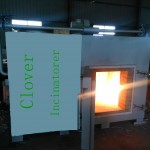1) Policy
– Waste disposal management shall be taken special note to prevent hospital infection.
– Infections wastes shall be managed, stored strictly and burned by a incinerator located at hospital site.
2) Waste Disposal Plan
- a)Classification
– Medical wastes in hospital are classified as follows;
| Infections Waste | Specially-controlled waste | Organ, needle, etc. |
| Industrial waste | Rubber gloves, etc. | |
| General waste | Gauze, etc. | |
| General Waste | Plastic, Rubber | Infusion bottle, etc. |
| Paper, wood, Vinyl | Voucher, etc. | |
| Metal, Glass | Can, Glass bottle |
- b) Infections Waste Disposal
– Segregation: Infections waste disposal shall be segregated appropriately and packed in particular containers and delivered to particular storage. The segregation, packing and delivery shall be operated appropriately at each room such as outpatient, operation theater, blood collection room and dialysis room.
– Precaution: Infections waste shall not be place in other containers on the way of segregation, packing and delivery.
– Storage: Infections waste shall be stored at the storage in hospital site temporarily until infections waste is incinerated.
– Incinerator:
It is designed to sterilize medical waste , reduce its volume , and render its components unrecognizable all in one fully enclosed and automated system.
It combines direct heated steam , high pressure and shredding to treat infectious materials.
The contaminated waste is loaded into the upper stainless steel chamber where a heavy-duty shredder reduces the waste into small pieces. Using gravity, the processed material falls into the treatment chamber where every piece is steam heated to 134 and pressurized to 3 to bar for 20 minutes. The operating conditions are continuously monitored and validated to achieve complete sterilization.
The 60 minutes average duration process cycle is totally automated. A computerized system monitors the process and automatically prints a report with the essential sterilizing parameters at the end of the cycle for accurate record keeping.
The capacity is between 500 to 600 kg/cy.h or more.
Treatment cycle:
1- Loading ; the contaminated waste is automatically -loaded into the chamber of the unit
2-Shredding; the heavy-duty shredder cut the material into small pieces and features a unique reversing system to avoid jamming
3-Heat; saturated pressurized steam raises the temperature to 134 C and the pressure to 3 bar
4-Sterilization; the sterilization comes into direct contact with the shredding material (134 c , 3 bar) for 20 minutes
5-Cooling; temperature is lowered to 80 C by spraying cool water onto Double jacket of the treatment vessel, simultaneously, the unit returns to ambient pressure
6-Draining; the steam is condensed to water and discharged with the cooling water to the sanitary sewer system
7-vacuum; the remaining residual steam is vented out through a vacuum pump
8-Unloading; a digital signal informs the operator that all safe operating conditions have been met
The condition unlocks the unit and allows gravity unloading of the treated waste into a container
Teaching Specification
General Characteristics
| Operational temp. max | 160 C |
| Max Weight when filld with waste For a special hydraulic test. Kg | 10500 |
| Stress. Kg/ cm3 | 3.5 |
| Steam Pressure. Bar | 8 |
| Max Steam Flow Kg/h | 500 |
| Compressed Air Bar | 6 |
| Electricity 380 V/3 – phase Surge Protection system | 35KW |
| Operating Characteristics | |
| Average Cycle Time. minutes | 60 |
| Process Wight Capacity . Kg | 500 – 600 |
| Density. Kg/m3 | 100 |
| Average process wight capacity Kg./cycle microbial inactivation | 200-300
8log 10 |
| Waste volume reductin | 80% |
| Consumption / Cycle | |
| Steam. Kg | 40 |
| Electricity . KW/h | 9 |
| Water Liters | 500 |
